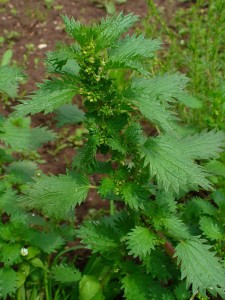By Gael (Plot 234)
Although a weed in our country, Stinging Nettle (Urtica urens and Urtica dioica ) are indeed interesting and reputedly health giving plants.
A gardener informed me today that she ate stinging nettle as a child in Europe and some varieties don’t actually “sting”.
Urtica dioica is a perennial while Urtica urens (the one usually found in our gardens) is an annual found in most temperate regions throughout the world. They prefer a moist soil rich in phosphorous and can be found in disturbed soil, compost heaps and paddocks containing cattle.
There are tiny hairs on their leaves and stems which is what causes the stinging sensation when touched leaving raised red marks on ones skin. These subside fairly soon leaving one more observant as to where they are growing. Be warned and wear gloves when handling them.
Nettles have a history of being used medicinally, the ancient Greeks using them for diarrhea and as a diuretic. They are reported to be valuable in low sodium diets as they supply minerals and natural salts. They are rich in Vitamin A and C, iron, potassium, manganese and calcium. Nettles are said to alleviate many health issues though this is not alway scientifically proven. Some of these claims include asthma, osteoarthritis,urinary tract infections, nose bleeds, cancer, sore throats, pregnancy, prostate problems and as a general tonic.
Ancient people used to make very durable cloth from nettle fibers, the Germans used nettles to make uniforms during the First World War. Steeping the nettles in very hot water briefly renders them stingless. They can be used as a vegetable by steaming them, chopping and sprinkling on salads and placing a sprig in a cup of boiling water for a deliciously mild tea.

They are not permitted in our community gardens for obvious reasons but a little patch at home can prove very useful. They do however aid the composting process and leaving the plant in a bucket of water for about three weeks or so makes a great fertiliser.
